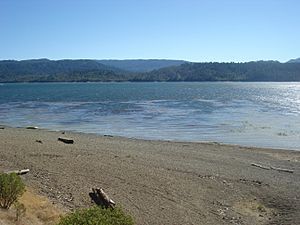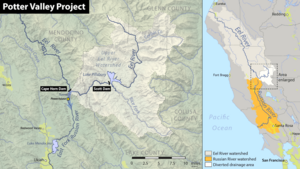Potter Valley Project facts for kids

The Potter Valley Project is a special system in Northern California. It moves water from the Eel River over to the top part of the Russian River. This project is owned and run by Pacific Gas and Electric Company (PG&E). Its main parts are two dams on the Eel River, a tunnel that moves water, and a power plant that makes electricity. On average, it moves about 159,000 acre-feet of water each year. This amount can change a lot depending on how much rain falls and how much water is needed in the Russian River area.
Contents
How the Project Started
The Potter Valley Project began way back in 1900. At that time, the natural flow of the Russian River wasn't enough for the growing farms and towns. A company called the Eel River Power and Irrigation Company started building it.
Building the First Parts
They first built the Cape Horn Dam. They also dug a one-mile (1.6 km) tunnel, about 8 feet (2.4 m) wide, under a mountain. This tunnel carried water to Potter Valley, which is at the start of the East Branch of the Russian River. The water then dropped 450 feet (137 m) to a power plant, where it made electricity before flowing into the Russian River.
Making Electricity
On April 1, 1908, the project started moving water and making power. It could make 4,000 kilowatts (KW) of electricity back then. By 1910, they boosted the power to 7,000 KW. In 1912, they added a second pipe to help more water flow through the tunnel. The power plant was finally upgraded in 1917, reaching its current power of 9,400 KW.
Adding More Storage
At first, the project could only work in winter. This was when there was enough water in the Eel River to move without drying up the river downstream. So, in 1920, they started building a bigger dam on the Eel River. This dam, called Scott Dam, was finished in 1922. It created Lake Pillsbury, which could store a lot more water. This meant the project could move water during the dry summer months. It also helped a little with flood control during winter storms.
New Owners and More Storage
In 1930, PG&E took over the project. Later, in 1959, another dam was built on the Russian River. This was the Coyote Valley Dam, which created Lake Mendocino. This new lake helped store even more water from the Eel River. Lake Mendocino is very important during dry years. It provides extra water when less water can be moved from the Eel River.
How the Project Works Today
The project collects water from a large area of 289 square miles (749 km2) above Scott Dam. It also gets water from about 50 square miles (129 km2) between Scott Dam and Cape Horn Dam. Most of this water comes from winter rain between December and April. Some also comes from melting snow and underground water until June.
Water Storage at Lake Pillsbury
Scott Dam creates Lake Pillsbury, which can hold about 74,993 acre-feet (92.5 million m3) of water. For safety, the gates at Scott Dam must be open between October 16 and April 1. This helps manage water during winter storms. The lake can only hold a small amount of floodwater. This is because the river's average yearly flow is over five times what the lake can hold. It's common for the dams to let out extra water many times during a single winter.
Summer Water Release
After the wet season, Lake Pillsbury starts to release water on April 1. Even in summer, the lake usually keeps at least 20,000 acre-feet (24.7 million m3) of water. Water flows from Lake Pillsbury to Cape Horn Dam. Most of this water is then sent through the tunnel to the Russian River. A small amount is released back into the Eel River. This helps keep the Eel River flowing naturally in summer. This flow is usually about 20 cubic feet per second (0.57 m3/s), but it can be less in dry years.
Who Uses the Water?
The water from the Potter Valley Project helps many people and places.
Farmers in Potter Valley
In 1924, the Potter Valley Irrigation District (PVID) was created. Its job is to give water to farmers along the East Branch Russian River. Today, 390 farmers use this water to irrigate about 4,905 acres (1,985 ha) of land. These farmers depend completely on the Eel River water. This is because there isn't much natural water or underground water storage in Potter Valley.
Towns and Farms Downstream
The project water also helps farmers and towns further down the Russian River in Mendocino County. They use about 17,000 to 23,000 acre-feet (20.9 to 28.4 million m3) of water each year. Even further downstream, people in Sonoma County use between 50,000 to 80,000 acre-feet (61.7 to 98.7 million m3) per year. These users get water from both the Potter Valley Project and natural flows in the Russian River.
Other Benefits
Besides farming, homes, and businesses, the project water also helps keep the Russian River flowing. It maintains a minimum flow of 150 cubic feet per second (4.2 m3/s) in the dry season. This is good for recreation, the beauty of the river, and for fish. It's thought that the project provides at least some water for nearly 500,000 people. These people live in Sonoma and Mendocino Counties, especially in the North Bay area, including cities like Santa Rosa.


